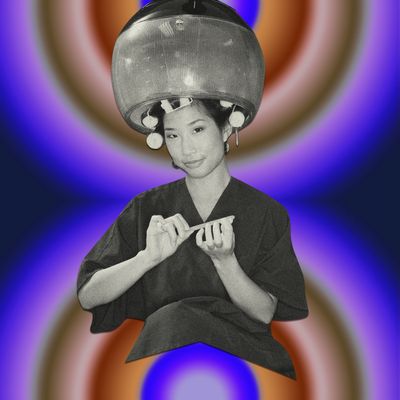
Dear Beauty Editor,
I love the short, curly K-pop-style hair, and I’m seriously considering a perm. Should I? What are they like these days? Will grow-out be a bitch?
—Anon
These days, there are as many permutations of the perm as there are BTS solo projects, which is to say: a lot. In fact, some of the trendiest perms — like the boy perm and the short, wavy style popularized by celebrities such as Kim Tae-hyung (a.k.a. V from BTS) — might be more correctly categorized as semi-permanent because they can be done with a chemical solution that temporarily changes the hair texture, making the grow-out process less tedious than it is with traditional perms. To get the look you’re after, find a stylist who has done it before and make sure the two of you are aligned on the type of perm you’re getting, how to care for it, and how to handle the regrowth process. Read on for some background info to consider before making your decision.
“When it comes to perms, the terminology is so screwed up, and I think that causes a lot of confusion,” says Monae Everett, a celebrity hairstylist and the founder of the Texture Style Awards. Generally speaking, you could call any chemical solution that alters the hair texture a perm — including relaxers, which are hydroxide-based solutions used to permanently break the disulfide bonds in curly and textured hair, causing it to straighten out. But nowadays, perm is more commonly used to refer to products with ammonium thioglycolate (ATG); stylists use these chemical solutions to break the disulfide bonds in hair, and then they reform the hair in a new shape and neutralize the solution so the hair remains in its new shape. This type of perm can be used to transform textured and coily hair into softer curls (think curly perm or GinaCurl) or reshape straight hair into waves, curls, or ringlets.
It sounds like you have short, straightish hair and you want a wave or soft curl. If your stylist uses a traditional (ATG-based) perming solution, the texture you end up with will depend on how the stylist sets, or shapes, your hair while it processes. “There are at least ten sizes of curlers you can use, but I’ve seen hairstylists getting much more creative and using flexi rods, rags — like, wrapping it around pieces of fabric — braids, and even twist sets,” says Everett. The key to getting the look you want is bringing a reference picture, so your stylist can create a similar curl or wave pattern using the mix of rollers or rods they think will work best.
In six to eight weeks, you’ll need a trim, another perm, or, most likely, both. “You’ll also have a little bit of an issue because your roots are a different texture from the lengths, so the two textures will be in conflict with each other and you may run into breakage,” says Everett. If you get this type of perm (which can cost $200 and up), the best thing you can do to ease the growing-out process is get your hair as healthy as possible before your first appointment. Everett recommends a strengthening treatment like ApHogee Two-Step Protein Treatment: “I know it’s old-school, but I don’t think I’ve come across anything that works better, especially on fine hair — you can feel the difference after using it,” she says.
Another type of perm your stylist may consider for the K-pop look is one that uses a cysteine-based solution. “It’s a different kind of chemical that’s more gentle — it’s not going deep into the hair to break those bonds, you’re just breaking the bonds that are more on the surface,” explains Briana Dunning, a stylist at Striiike in Beverly Hills. She uses a cysteine-based solution for Striiike’s New Wave, a semi-permanent wave treatment that costs $450. (Other salons offering similar treatments with cysteine- or cysteamine-based solutions may call the process a body wave, beach wave, permanent wave, soft perm, or even an “organic perm.”)
When she’s doing a New Wave, Dunning customizes the wave pattern based on each client’s cut and existing texture, and she typically uses foam rollers to create the shapes. “The best part about it is that there are no harsh lines of regrowth, because the texture fades the more you wash your hair,” she says. “Typically, it’ll last three to five months, and you can come back for another process or just be one and done.” The less you shampoo, the longer this type of semi-permanent “perm” will last, says Dunning. (For clients who work out often, Dunning created Unsubscribe, a no-rinse hair wash: “It doesn’t absorb oil like a dry shampoo — it leaves hair with a kind of satiny finish with a little bit of texture and it neutralizes any smell from the scalp or sweating so you don’t have to shampoo.”)
Now that you have more info on the latest in perms, it’s time to do your research — and I don’t mean Googling chemicals. Get on Instagram and TikTok and look for stylists who are showcasing photos of clients with the look you want. Or find someone whose style you like and ask them who their stylist is. Then book a consultation with a stylist to start. Bring pictures and tell them about your hair, any chemical processes you’ve had in the past (be honest!), how you style it, and what type of maintenance and upkeep you can honestly handle and commit to. If you like their vibe and trust their expertise, then trust what they tell you — even if they recommend not getting a perm. “Some chemically processed hair absolutely cannot be permed,” warns Everett. “Mixing the wrong chemical processes will literally make the hair melt and break.” And you don’t want to lose all your hair for a passing fad, no matter how good it looks right now.
Jennifer Sullivan answers all your beauty-related questions with practical advice and zero judgment. Send your questions to [email protected]. (By emailing, you agree to the terms here.)
More Beauty Advice
- How Do I Prevent Botox Immunity?
- Do Perfume Oils Last Longer Than Sprays?
- How to Layer Your Skin-Care Products in the Right Order


